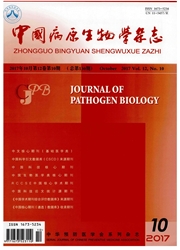

 中文摘要:
中文摘要:
目的 了解昆明地区肠黏附性大肠埃希菌(Enteroaggregative Escherichia coli,EAEC)的流行特征,为防治EAEC感染提供科学参考。方法 收集云南省昆明市4家哨点医院的腹泻患者粪便标本1 121份,非腹泻者的粪便标本319份,进行细菌培养(麦康凯培养基),无菌挑选单个菌落(8-12个),采用热提取法提取细菌DNA,采用荧光定量PCR检测EAEC,同时使用结构化问卷收集研究对象的基本信息。结果 EAEC在腹泻患者和非腹泻者中的检出率分别为5.4%和1.3%,差异有统计学意义(χ2=10.104,P〈0.05)。男、女腹泻患者EAEC检出率分别为5.2%和5.7%,差异无统计学意义(χ^2=0.140,P〉0.05);不同年龄组腹泻患者中EAEC检出率差异无统计学意义(χ^2=10.865,P〉0.05);腹泻患者EAEC检出率有明显的季节分布特征(χ^2=12.819,P〈0.05),夏季检出率最高(10.5%,21/200);冬季最低(2.0%,8/394)。EAEC阳性腹泻患者水样便占26.2%(16/61),黏液样便占70.5%(43/61)。EAEC腹泻患者易出现呕吐症状(χ^2=12.819,P〈0.05)。结论 EAEC是腹泻的重要细菌性病原体,开展和加强EAEC的监测,可为EAEC相关腹泻的预防和控制提供科学依据。
 英文摘要:
英文摘要:
Objective To examine the epidemiological characteristics of enteroaggregative Escherichia coli (EAEC) in the City of Kunming, Yunnan Province in order to provide a scientific reference for the prevention and treatment of EAEC infection in China. Methods A total of 1,121 patients with diarrhea and 319 healthy controls were recruited from four sentinel hospitals in the City of Kunming from June 2014 to July 2015. Stool samples were cultured (MacConkey agar), single colonies were selected (8--12 single colonies), and total genomic DNA was extracted (heat extraction) to detect EAEC with real-time polymerase chain reaction (RT-PCR). A structured questionnaire was used to obtain basic informa tion and information on clinical manifestations. Results EAEC was detected at a higher rate in patients with diarrhea than in controls (5.4%, 1.3%, x2= 10. 104, P〈0.05). The prevalence of EAEC did not differ significantly between male and female patients with diarrhea (5.2%, 5.7%, x2 =0. 140, P=O. 709). The rate at which EAEC was detected did not differ significantly by age group (x2= 10. 865, P=-0. 054). EAEC was detected in patients with diarrhea accord- ing to marked seasonal trends (X2=12.819, P〈0.05). EAEC was most often detected in the summer (10.5%, 21/200)
 同期刊论文项目
同期刊论文项目
 同项目期刊论文
同项目期刊论文
 期刊信息
期刊信息
